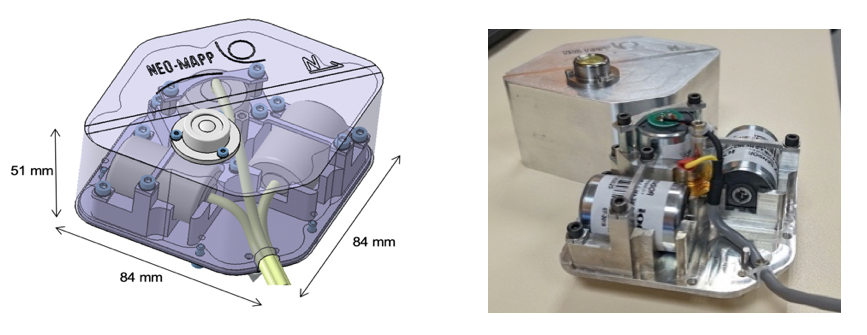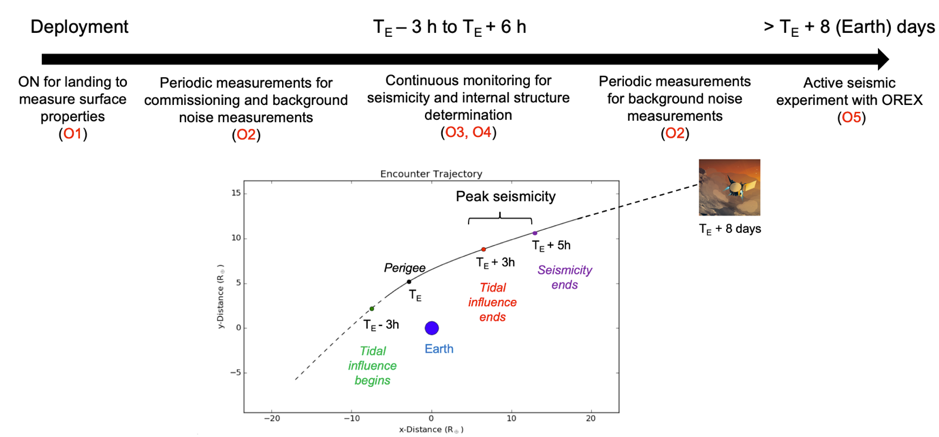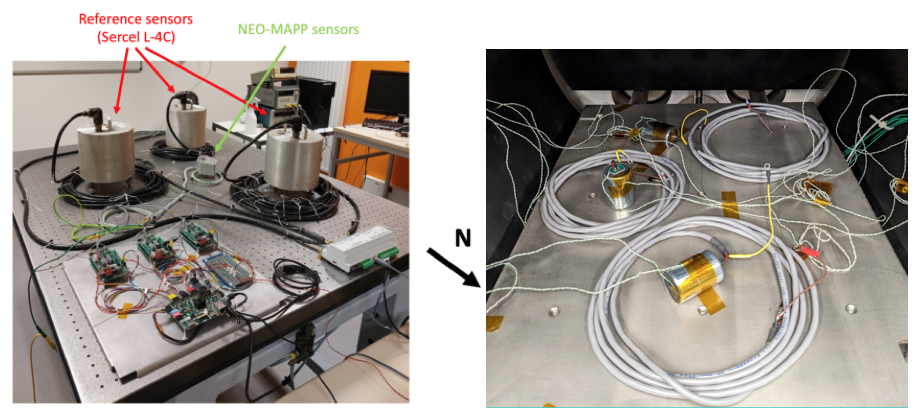An in-situ seismic investigation of asteroid Apophis
- 1ISAE-SUPAERO, DEOS, Toulouse, France (naomi.murdoch@isae.fr)
- 2The University of Maryland, College Park, USA
- 3IPGP, University Paris Diderot, Paris, France
- 4Université Côte d’Azur, Observatoire de la Côte d’Azur, CNRS, Laboratoire Lagrange, Nice, France
- 5CNES, Toulouse, France
Introduction: The tidal encounter of asteroid Apophis with the Earth in 2029 offers the ideal scenario for the first in-situ seismic investigation of an asteroid. A seismometer can be used to monitor the seismicity of Apophis due to tidal forces [1], and other natural sources such as micro-meteoroid impacts or thermal cracks; [2-4]. In addition, a seismometer can image Apophis’ sub-surface and internal structure [2] providing information about the asteroid’s physical properties that is critical for planetary defense, and for understanding the evolutionary history of asteroids. As a consequence, there is strong international support for the first seismic experiment on an asteroid.
We have developed a Compact Seismometer that is designed specifically to fit inside a small asteroid surface package and function in the challenging environment of the asteroid surface. The instrument team has extensive experience in developing, testing, and operating seismic [5,6] and acoustic [7] planetary instrumentation.
Scientific Objectives: The main science and technological goal of the Compact Seismometer is to perform the first ever in-situ seismic study on the surface of an asteroid. The specific compact seismometer science objectives are as follows:
Threshold science objectives:
(O1) Constrain the mechanical properties of the surface during landing
(O2) Measure the seismic background noise on the surface of Apophis
Baseline science objectives:
(O3) Quantify the seismicity of Apophis in response to tidal forces
(O4) Probe the subsurface and internal structure of Apophis
Bonus objective:
(O5) Perform the first active seismic experiment on an asteroid using the OSIRIS-APEX spacecraft – surface interactions
Compact Seismometer: The instrument consists of three commercial geophones that will each measure the ground motion along one axis, and dedicated electronics (Figs 1-2). The geophones are passive, contain no active electronics and are designed to withstand extreme environments (e.g., terrestrial boreholes). The analog electronics have been carefully designed and developed to have a high sensitivity and low intrinsic noise. The instrument is currently at TRL level 4/5 (4 for the electronics, 5 for the commercial sensors), and the development schedule is compatible with RAMSES schedule. The current best estimates of the instrument mass, volume and power budgets are ~1 kg, 0.8 L and ~ 2W, respectively.

Figure 1. (left) Schematic diagram of the Compact Seismometer. (right) The Compact Seismometer containing three geophones.
Operational scenario: The Compact Seismometer should be deployed to the surface of Apophis prior to the asteroid’s closest encounter with the Earth. In the lead up to the perigee, periodic measurements will be made for instrument commissioning and background noise measurements. Then, from 3 hours before to 6 hours after the perigee - when tidal-induced seismic activity is expected to occur [1] - continuous monitoring should be performed. Following the close encounter further periodic measurements should be made to monitor the evolution and diurnal variations of the background noise and seismicity. If the surface package can survive long enough, the OSIRIS-APEX excavation experiment using thrusters [8] would provide a unique opportunity to perform an active seismic experiment using the Compact Seismometer.

Figure 2. Possible concept of operations for the Compact Seismometer.
Surface coupling and levelling: The Compact Seismometer must land on the asteroid and be in contact with the asteroid’s surface. However, the Compact Seismometer can operate in any orientation and does not require levelling. The proposed solution is to not attempt to couple to the surface; any coupling attempt will only couple the instrument to the upper layer of regolith, which itself may not be coupled to the sub-surface. If any lofting occurs, these events can be used to characterize the surface properties during the subsequent touchdown.
Performance and environment testing: The expected noise level of the Compact Seismometer is <1.0E-9 m/s/sqrt(Hz) in the 5-200 Hz bandwidth (<1.0E-7 m/s2/sqrt(Hz) at 15 Hz). Performance tests of the Compact Seismometer have characterized the electronic noise floor, distortion, cross talk, and the integrated instrument performance. The performance evaluation of seismic instrumentation is particularly complex due to the terrestrial seismic environment. However, we rely heavily on the experience and expertise gained from the SEIS (InSight) instrument and ARTEMIS-4 geophone performance testing. Thermal vacuum (TVAC) testing of the Compact Seismometer (Fig. 3) sensors demonstrated that the sensors survived the environment testing and that the noise level and the transfer function before and after TVAC remain unchanged.

Figure 3 (left) Compact Seismometer performance testbed at ISAE-SUPAERO. (right) Compact seismometer sensors during TVAC testing.
Conclusions: The Apophis 2029 encounter with the Earth offers the ideal scenario for the first in-situ seismic investigation of an asteroid. There is a strong interest within the planetary science and seismology community, and large international support for the first seismic experiment on an asteroid. The Compact Seismometer – the result of over a decade of studies and development – is designed to fit inside a small lander and function in the challenging environment of an asteroid’s surface. The team has extensive experience in developing, testing and operating seismic and acoustic planetary instrumentation. The Compact Seismometer is currently at TRL 4/5 (4 for electronics, 5 for commercial sensors), and the development timeline is compatible with the ESA RAMSES mission schedule.
Acknowledgments: The authors acknowledge funding support from CNES and from the European Commission's Horizon 2020 research and innovation programme under grant agreement No 870377 (NEO-MAPP project).
References: [1] DeMartini, J. et al. (2024), EPSC. [2] Murdoch, N. et al., (2017) Planetary and Space Science, 144, 89-105., [3] Murdoch, N. et al., (2015) Asteroids IV, University of Arizona Press Space Science Series. [4] Compaire, N., et al. (2022). Geophysical Journal International, 229(2), 776-799. [5] Lognonné, P. et al., (2019) Space Science Reviews. [6] Mimoun, D. et al. (2017) Space Science Reviews, 211. [7] Mimoun, D. et al. (2023) Space Science Reviews, 219. [8] DellaGiustina, D. et al (2023) Planet. Sci. J. 4 198.
How to cite: Murdoch, N., Garcia, R. F., Sournac, A., Cadu, A., Wilhelm, A., Drilleau, M., Stott, A., DeMartini, J., Kawamura, T., Lognonné, P., Michel, P., Bousquet, P., and Mimoun, D.: An in-situ seismic investigation of asteroid Apophis, Europlanet Science Congress 2024, Berlin, Germany, 8–13 Sep 2024, EPSC2024-495, https://doi.org/10.5194/epsc2024-495, 2024.